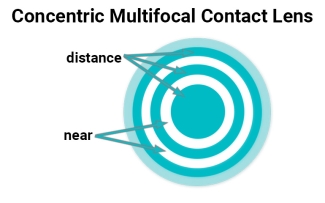Can you get contact lenses for reading?
In today’s fast-paced world, new ways constantly evolve to communicate, access information, and enjoy your favourite books. What remains constant is the challenge that adults over 40 experience when reading.
It’s around age 40 that presbyopia — the normal loss of near focusing ability — begins to set in. This refractive error makes it difficult to read and see small details clearly as you get older.
Whether you’ve started magnifying the text on your phone or on the pages of a good book, contacts for reading can be a game changer. Below, we discuss the different reading contact lens options for people with presbyopia.
Can you wear contact lenses if you only use glasses for reading?
Technically, you could wear single-vision contact lenses for reading only, but doing so is pretty uncommon. After all, you don’t spend 100% of your day looking at up-close text and objects.
Since it's not very common to utilize contacts for reading only, a much-used alternative is to wear multifocal contact lenses with multiple zones of power (or strength). If you only use glasses for reading, you would have no prescription strength in the contact lens sections designed to correct distance vision. This would leave only the reading and intermediate segments of the contact lens with any sort of magnification.
It’s also important to note that dry eye syndrome becomes more prevalent with age and contacts can worsen dry eye symptoms.
With this in mind, wearing contact lenses only for reading may not be the most practical solution. Reading glasses are more commonly recommended for people who only need near vision correction for presbyopia.
Types of contact lenses for reading
There are several types of reading contacts that can correct vision for people with presbyopia. Below are some different options with explanations on how they work and who they fit best.
Multifocal
Multifocal lenses contain multiple prescriptions in each lens to correct vision at multiple distances:
- Near (reading)
- Intermediate (computer)
- Far (driving)
The prescription strengths may be arranged in concentric rings that resemble a target. Or they may have a more subtle transition between correction zones, as with aspheric lenses. The aspheric design is similar to progressive eyeglass lenses, allowing your eyes to seamlessly switch focus between distances.
Best for: Someone who needs vision correction at multiple distances and prefers a seamless transition between prescription strengths
Bifocal
Bifocal contact lenses are a type of multifocal with only two distinct zones:
- One that corrects distance vision
- One that corrects near vision
Bifocal lenses typically have a segmented design, with distance correction at the top of the lens and near correction at the bottom. This is called a “translating design” contact lens. This design is most common for rigid gas-permeable contact lenses.
Best for: Individuals who require distinct near and far vision correction, and prefer a clear separation between the two
Monovision
Monovision contact lenses correct presbyopia, but in a different way than multifocals. Rather than having multiple correction zones in a single lens, each monovision lens has a different single-vision prescription. Specifically:
- The lens in one eye corrects distance vision
- The lens in the other eye corrects near vision
Typically, the dominant eye is fitted with the lens for distance correction, while the non-dominant eye gets the lens for near vision. Your eyes will then work together so you can see clearly at every distance.
Best for: People with presbyopia who want to reduce their reliance on reading glasses and may not be a good fit for multifocal contacts. It might take some time to adapt to monovision, but it’s a popular solution for those who need help with both distance and close-up tasks.
Rigid gas-permeable (RGP) and scleral lenses
Rigid gas-permeable (RGP) lenses are known for their material makeup rather than the vision problems they correct. They are made of durable materials that allow oxygen to pass through to the eye. This can help offset dry eye symptoms that may occur with contact lens use, providing both comfort and clarity.
RGP lenses can be used for single-vision correction or made with bifocal and multifocal designs to aid with reading, intermediate, and distance vision.
SScleral lenses are a specific type of RGP lens. Each lens vaults over the cornea (the front surface of the eye) and rests on the sclera (the white part of the eye). Sclerals are often recommended for people with ocular surface disease or irregularly shaped corneas, though multifocal scleral lenses are also prescribed for people with presbyopia.
Best for: People with irregular corneas or dry eyes, or those seeking added comfort and clarity with contact lens use
Candidates for reading contact lenses
Talk to your eye care provider to find out if you’re a good candidate for reading contact lenses. They can make recommendations based on your eye health and vision needs.
If they determine that contact lenses for reading are a good option, you’ll need to have a contact lens exam to determine your contact prescription. This exam includes a special contact lens fitting to find out which brand and type of lenses fit your eyes best and most comfortably. Once you have your prescription, browse through our inventory of contact lenses to find your fit.
SOURCES
- Dry eye syndrome. Stat Pearls [Internet]. February 2024.
- Dry eyes and contact lenses: Do's and don'ts. Healthgrades. September 2021.
- Should you get bifocal contact lenses? GoodRx Health. August 2021.
- Monovision contact lenses for presbyopia. Verywell Health. April 2022.
- Gas permeable contact lenses (RGP or GP). Vision Center. February 2024.
- Managing presbyopia with sclerals. Review of Cornea & Contact Lenses. March 2


